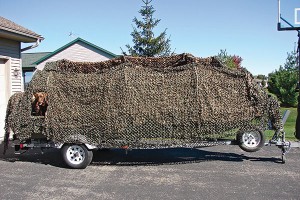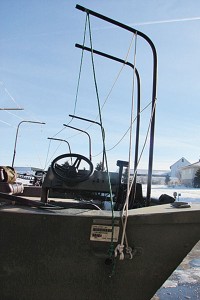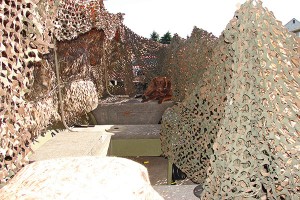December 11, 2013
By Mike Marsh
 Scott Hogland of Dane, Wis., is a relative newcomer to duck hunting, who came up with some innovative ideas for dealing with old challenges.
Scott Hogland of Dane, Wis., is a relative newcomer to duck hunting, who came up with some innovative ideas for dealing with old challenges.
Hogland devised a way of building a pop-up blind on a john boat. Like many hunters, he used EMT electrical conduit, but manufactured an extremely lightweight (and inexpensive) frame for easy set-up and take down. His rope and conduit pop-up blind will fit the needs of many waterfowlers, and received an honorable mention in the 2012 Boats & Blinds contest.
"We shoot mainly mallards, but have also decoyed a ton of divers, including bluebills, goldeneyes and ringnecks," said Hogland, who served as a fishing guide in his younger days. "Last year right after Thanksgiving, I hunted with a friend and his father-in-law. It was a nasty, cold day and we had a fantastic hunt. Almost everyone shot their limits of buffleheads, mallards and Canada geese."
He now hunts the same lakes where he once guided anglers, including his favorite, Lake Wisconsin, a huge public reservoir that is 14 miles long.
Advertisement
"It has special regulations like our other, smaller public reservoirs that require all hunting blinds to be within a foot of rooted shoreline vegetation," he said. "I hunt the backs of bays and sloughs and the blind blends right in. It fools ducks and geese completely."
Hogland does a good bit of work with electricians on large commercial job sites, so he knew he could make the blind's supports out of EMT. He did not want the blind to have a fixed support system, even though it would have been more sturdy.
"The blind system worked very well for me in 2012, which was my first full season of duck hunting seriously," he said. "I hunted up to three adults comfortably, and by the end of the year I was able to set up or take down the blind in a matter of minutes. By using a combination of camouflage materials, I was able to blend the boat in very well with the shoreline cover where we hunted."
Advertisement
Support System
Building the blind begins with the support poles. Hogland used five on each side of his 17-footer, but other boats will require three to five supports depending primarily on the length, seat, console and storage compartment configuration.
 Using a pipe bender, each support pole is curved inward at a 90-degree angle at the top and bottom. The rear support poles of Hogland's blind are 48 inches high and bend inward at the top to provide an overhang of 24 inches for the roof. The bottom sections bend inward 6 to 8 inches, with this short length providing axles for the pivot points that allow the blind to rotate down toward the stern.
Using a pipe bender, each support pole is curved inward at a 90-degree angle at the top and bottom. The rear support poles of Hogland's blind are 48 inches high and bend inward at the top to provide an overhang of 24 inches for the roof. The bottom sections bend inward 6 to 8 inches, with this short length providing axles for the pivot points that allow the blind to rotate down toward the stern.
The front support poles bend 90 degrees inward at the bottom to provide the same 6- to 8-inch pivot point axles, then rise to a height of 34 inches before being bent inward approximately 45 degrees to provide an overhang of 14 inches. A shooting port runs the length of the boat between the front and rear frames, and the ends of the supports are taped to keep water out and painted to match the final camouflage pattern.
Holes are drilled through the supports perpendicular to the deck. Two holes are drilled into the top of each of the blind's rear section "roof" support overhangs, one hole at the beginning of the 90-degree curve and one midway up the horizontal side. In the front section, one hole is drilled near the top end, one at the curve and another midway up the horizontal side.
Bottom axles are attached to the casting platforms and seats with metal conduit straps that are screwed through the carpet and into the aluminum with self-tapping screws. The fit is loose enough to allow the frame uprights to rotate flat, toward the stern.
Ropes are threaded through the holes. Once the correct fit is found by repeatedly folding the frames up and down, an overhand knot is tied on both sides of each hole in the frames. Except for the rope at the top curve of the rear frame, all ropes are tied to a pair of carabiners that clip to each of the rear boat handles.
The rope at the top curve of the rear frames extends only through the outermost frames. All other ropes are tied to a heavy-duty split ring at the bow. Another short piece of rope is tied to the split ring and to a carabiner that clips to the bow eye. This short piece of rope takes up all of the tension for the final adjustments and any field adjustments.
Camo-Concealed
Hunter's Specialties blind material is attached to the front of the blind, but is only zip-tied to the angled top section. The supports must lay flat without tearing the material. Some excess material drapes over the side of the boat. Military camouflage netting is attached over the other material using zip ties.
Brown or camouflage waterproof tarp material is attached to the rear frames using zip ties to secure only the top sections above the 90-degree curves. Military camouflage netting is zip-tied over the tarp. Hunter's Specialties blind material can be used in lieu of the tarp, but will not protect hunters from rain.
 Hogland's boat has a fishing seat in the stern and one in the bow, plus a live well on one side where one or two hunters can sit. A notch cut into the camouflage fabric allows the retriever to enter and exit from a casting platform that he had previously built into the stern of the boat. The blind material extends partially around the outboard motor, but Hogland tosses a separate, loose piece of camouflage fabric over it for total concealment.
Hogland's boat has a fishing seat in the stern and one in the bow, plus a live well on one side where one or two hunters can sit. A notch cut into the camouflage fabric allows the retriever to enter and exit from a casting platform that he had previously built into the stern of the boat. The blind material extends partially around the outboard motor, but Hogland tosses a separate, loose piece of camouflage fabric over it for total concealment.
"The materials are inexpensive and easy to take off the boat," he said. "I will be able to use all of the materials again next year as there was little damage to any of it. The exception was one area on the back where my 18-month-old Lab decided to jump from the bank back into the boat through the netting and I had to patch the hole."

